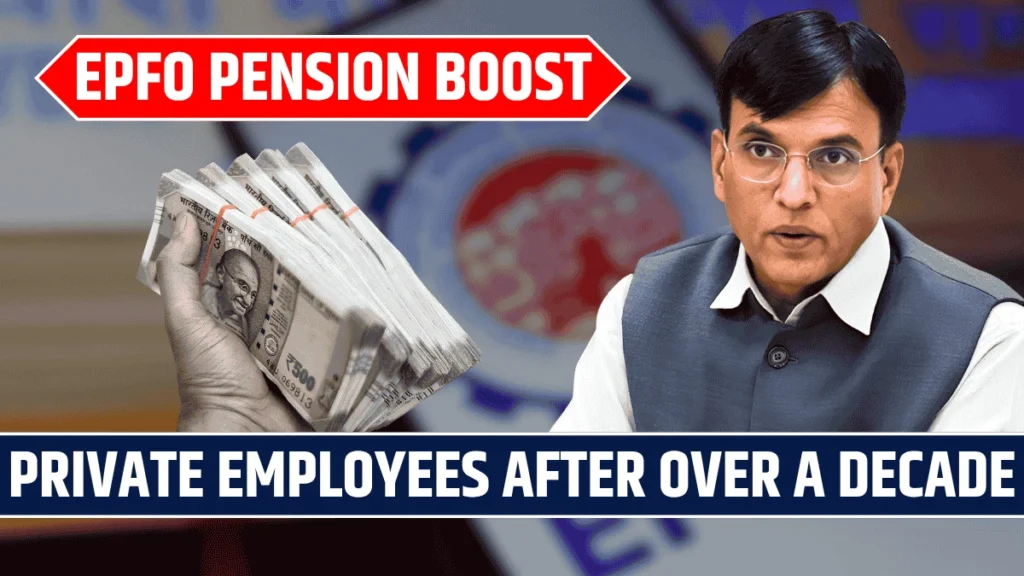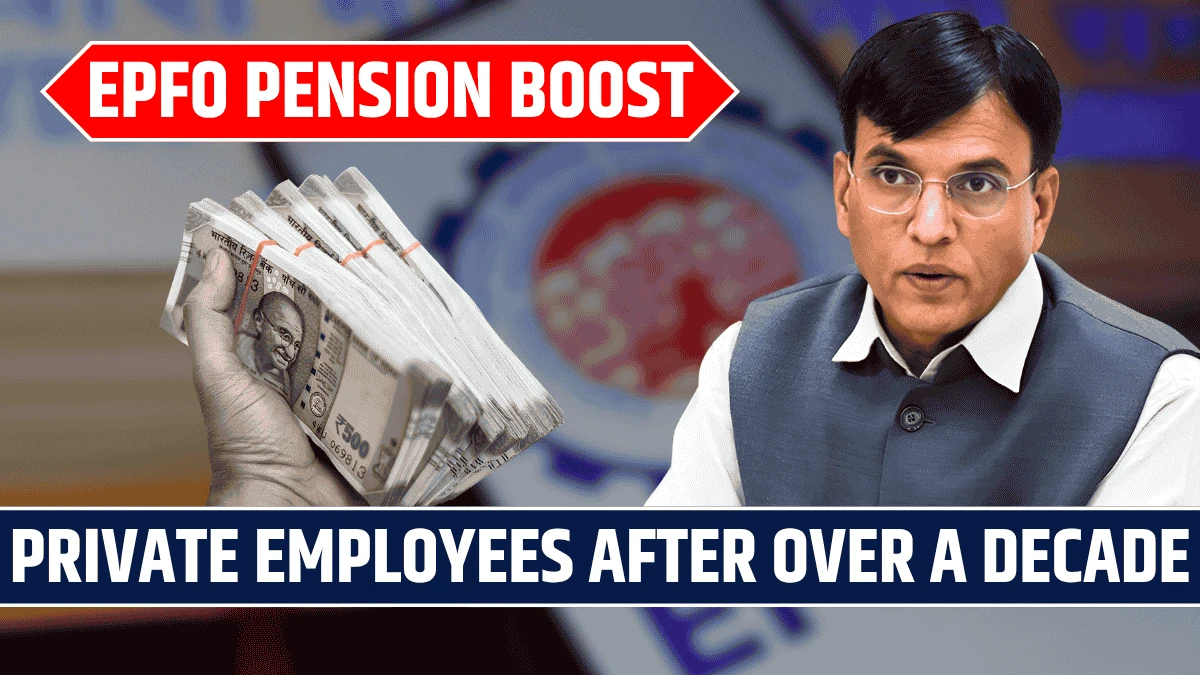After more than a decade without a real uplift, India’s private sector workforce may finally see a meaningful boost to their Employees’ Pension Scheme benefits. Conversations within policy circles have intensified around improving EPS-95 pensions, especially the minimum pension that has remained static since 2014. For millions of salaried employees who rely on EPF and EPS as the backbone of retirement income, this is the update they have been waiting for. While the final contours will only be clear once an official notification is issued, the direction of travel points toward stronger, more predictable monthly pensions for private employees.

A Decade In Waiting
The last landmark change came in 2014, when the EPS wage ceiling was raised and a minimum monthly pension of ₹1,000 was introduced. In the years since, inflation and rising living costs have steadily eroded the purchasing power of that floor. Retirees and trade bodies have repeatedly sought a revision, arguing that a static minimum pension undermines the promise of basic retirement security for low and middle-income earners. Coupled with demographic shifts and longer lifespans, the case for an increase has grown stronger with each passing year.
What Is Changing Now
Policy discussions have moved toward improving EPS adequacy in practical terms. The most anticipated move is a higher minimum pension, with widely discussed figures in the ₹2,000 to ₹3,000 range. Alongside that, there is ongoing debate about the EPS wage ceiling, which defines how much of the employer’s contribution is directed to EPS. Any change here would shape future accruals. Nothing is final until the government and EPFO publish a circular, but signals suggest the next EPS update will aim at delivering a more livable monthly pension.
Why It Matters Today
An EPS uplift would matter for three kinds of people. It will help current pensioners on low monthly payouts cope with day-to-day expenses. It gives near retirees more clarity over what to expect from their monthly annuity. And it supports younger members by improving the foundation of a lifetime pension, compensating in part for the volatility of market-linked retirement options. This is not just a technical tweak; it changes the math for retirement planning and could narrow the gap between expectations and actual post-retirement income.
Who Might Benefit Most
Members with long, uninterrupted service under EPS typically gain more from any formula improvement, because their accrued service multiplies the pensionable salary base. Low-wage members and those currently receiving pensions at or near the existing minimum could benefit immediately if the floor rises. Near retirees may also gain if a higher wage ceiling or a favorable recalibration applies prospectively to their final years of service. Even for those who move jobs frequently, a higher floor acts as a safety net across fragmented service histories.
How The Boost Works
EPS is a defined benefit layer within the broader EPF framework. The monthly pension is calculated from two key components: pensionable salary and pensionable service. Pensionable salary is typically the average of the last sixty months of eligible wages, subject to the statutory wage ceiling. Pensionable service is the total eligible service, with certain bonuses for long tenures. The formula then converts that salary and service into a lifelong annuity. A higher minimum pension lifts the base below which a member’s payout cannot fall. A higher wage ceiling allows more of the employer’s contribution to flow into EPS, potentially lifting the calculated pension over time.
Link To Higher Pension
This anticipated boost is separate from the higher pension option that drew attention after the Supreme Court verdict in 2022. The higher pension route was about allowing eligible members to contribute based on actual pay rather than the capped wage ceiling, resulting in a higher formula-based pension but a smaller EPF lump sum. A rise in the minimum pension benefits everyone at the lower end regardless of whether they chose the higher pension path. If the wage ceiling itself changes, that will primarily affect future accruals; past service will usually follow the rules that applied at the time.
Salary Ceiling And Contributions
Today, employers split their statutory contribution between EPF and EPS, with 8.33% directed to EPS but only up to the wage ceiling. If the ceiling goes up, a larger share of the employer contribution migrates to EPS, raising the future pension base. For employees, the twelve percent contribution to EPF remains unchanged. Take-home pay typically does not decline because EPS contributions come from the employer side or from reallocation within the employer’s share. The trade-off is long-term: more in EPS means less accumulating in the EPF lump sum, but more guaranteed monthly income later.
Possible Increase Scenarios Ahead
Three broad scenarios have been widely discussed. The first is a simple lift in the minimum pension, which immediately helps current pensioners and sets a stronger floor for future retirees. The second is a wage ceiling hike, improving accruals for members with higher basic wages going forward. The third is a modest recalibration of the calculation or qualifying rules, such as service-related enhancements for long tenure, which makes the benefit more responsive to career-long contributions. The final package could blend these approaches, balancing adequacy for retirees with sustainability for the fund.
Impact On Take Home
For most salaried employees, there should be little to no impact on the monthly take-home if the change primarily adjusts the employer’s allocation between EPF and EPS or lifts the floor on pensions. The real difference emerges at retirement. A stronger EPS benefit translates into more predictable income each month, which can reduce how much you need to draw from your EPF corpus or other investments in the early years of retirement. Members who had opted for higher pension may notice a greater tilt toward annuity income relative to lump sum, a trade-off that is consistent with their original choice.
Tax Rules And Planning
EPS pensions are taxable as regular income under prevailing slabs, and tax is typically deducted at source once monthly pensions cross threshold limits. EPF withdrawals, by contrast, are generally tax-exempt if taken after five years of continuous service and subject to the usual conditions. A higher pension improves cash flow but may also push some retirees into a higher tax bracket, so it is sensible to plan for net income after tax. The standard deduction available to pensioners can ease the burden, and tax relief rules may apply in specific situations, but the key is to estimate post-tax cash flows and align them with essential expenses.
What To Do Now
Start by reviewing your EPFO passbook and service history so you know the years of pensionable service recorded against your UAN. Make sure KYC details are complete, including Aadhaar, PAN, and bank account information, because clean records speed up any recalculation or arrears processing. If you changed jobs, verify that all your past PF accounts are linked under your UAN and that service overlaps or gaps are resolved. Keep recent salary slips and appointment letters handy; they are often needed for reconciliations. If you opted for higher pension, track your application status and updated calculations closely. Above all, wait for the official circular to understand the exact eligibility, effective date, and documentation required.
Watch For Official Notifications
The concrete details will be published through EPFO and Ministry of Labour notifications, followed by implementation guidance to field offices and employers. Expect timelines for effective dates, instructions on how existing pensioners will be adjusted, and whether arrears will be paid from a retrospective date. Employers and payroll providers will update their systems once the rules are final. If you are already on pension, your bank mandate and PPO details must be correct to receive any revised amount without delays.
Frequently Asked Questions Answered
Many members ask whether the boost helps current pensioners. If the minimum pension is raised, current pensioners below the new floor generally see an immediate increase from the notified effective date. Another common question concerns employees close to retirement. If a wage ceiling revision applies prospectively, it may improve the last years of accruals but will not rewrite older service under previous rules. People also ask about EPF interest and EPS payouts. EPF interest rates affect the lump sum corpus and are separate from EPS, which is a fixed formula pension not influenced by market returns.
Closing Thoughts For Members
For private sector employees, a stronger EPS is more than a headline; it is a step toward dignified, dependable retirement income. The likely pension boost after a long gap recognizes how much the cost of living has changed since the last revision. Keep your records tidy, monitor official updates, and run fresh retirement numbers once details are confirmed. With better visibility on monthly pension and a disciplined approach to EPF and other savings, you will be better positioned to turn your working years into stable, sustainable income for life.
Disclaimer
This article is for general information and educational purposes only. It should not be treated as financial, tax, legal, or pension advice, nor as a recommendation to make any specific decision. Rules governing EPFO and the Employees’ Pension Scheme may change through government notifications, court rulings, and administrative circulars. Examples, figures, and scenarios are illustrative and may not reflect the latest updates or your personal circumstances.
